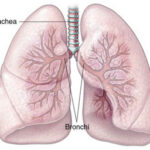While the term has been around for generations, Croup is a general term, usually referring to a condition also known as laryngo-tracheo bronchitis – an infection of the larynx and/or the throat of a child. Upper respiratory infections in children can affect the tonsils, the larynx and other parts of the tracheal tree. These infections can be due to other viruses or influenzal organisms like streptococci, pneumococci, etc.
The symptoms of croup explain how the condition got it’s name – because children have a small tracheal airway (about the diameter of a pencil), an infection can be rather serious and make it difficult for breathing to occur through the narrow passageway. This results in a harsh, barking cough, hoarseness, wheezing and a genuine difficulty getting air into the respiratory system. Some children even turn a bit bluish since there is a lack of oxygen getting into their system. Breathing will be noisy since children must work so hard to get air and oxygen through the narrow, infected bronchial airway. Children may also have congestion and mucus or pus that is difficult for them to cough up with the restricted air flow and illness.
There are two “old fashioned” remedies for helping a child who is suffering from croup. The first is to place the child in an atmosphere filled with steam – a small bathroom with a hot shower and hot water tap running are one suggestion. Keeping the child in a steamy room will help to relieve some of the congestion. Cool night air can also help to relieve congestion. A vaporizer is another good tool for creating a humid environment. The second old-fashioned method, which isn’t recommended as often any longer, is to give the child some syrup of ipecac to induce vomiting. In the process of vomiting, he may get rid of a lot of the thickened mucus that is trapped in the chest.
Doctors also recommend Acetaminophen to bring down any fever and provide relief from other aches and pains which may make it easier for the child to relax and breathe easier.
Serious illness or severe cases of the croup should be seen by a doctor. There are complications, such as respiratory distress that could result in children where breathing becomes extremely labored. Dehydration could also become a problem if children are so constricted they are not taking in enough fluids.
For more information about the Croup – including good color images of how the child’s throat and larynx are affected by respiratory infections, the United States National Library of Science and the National Institutes of Health have a website found at http://www.nlm.nih.gov/medlineplus/ency/article/000959.htm. This site provides a good overview on symptoms and treatment, as well as links to other online resources.



